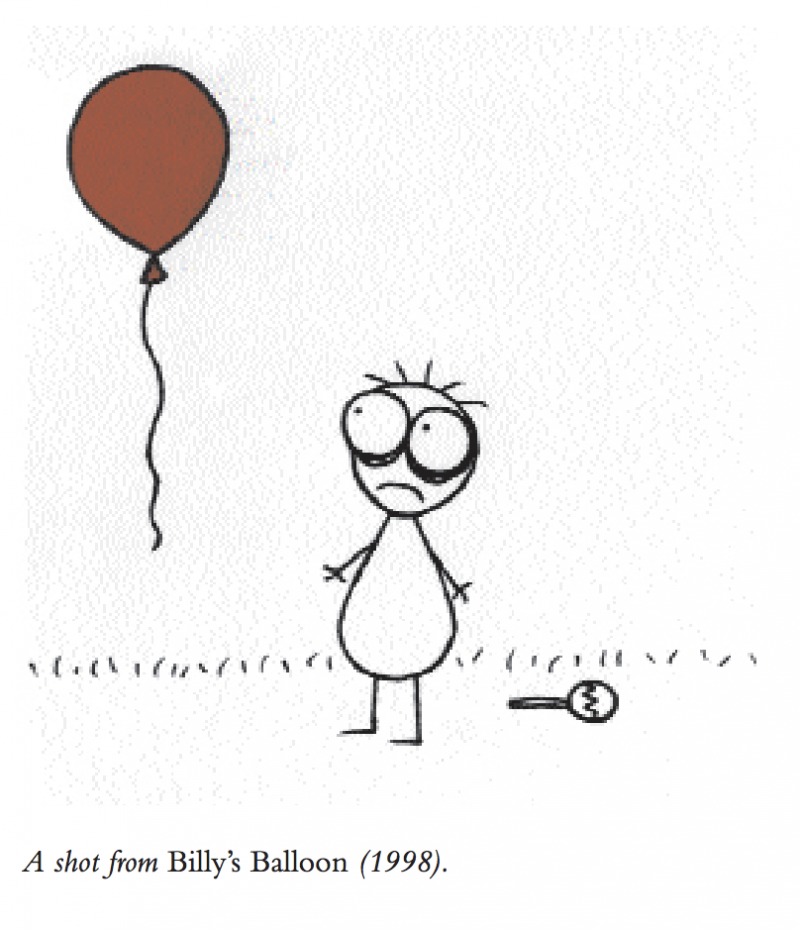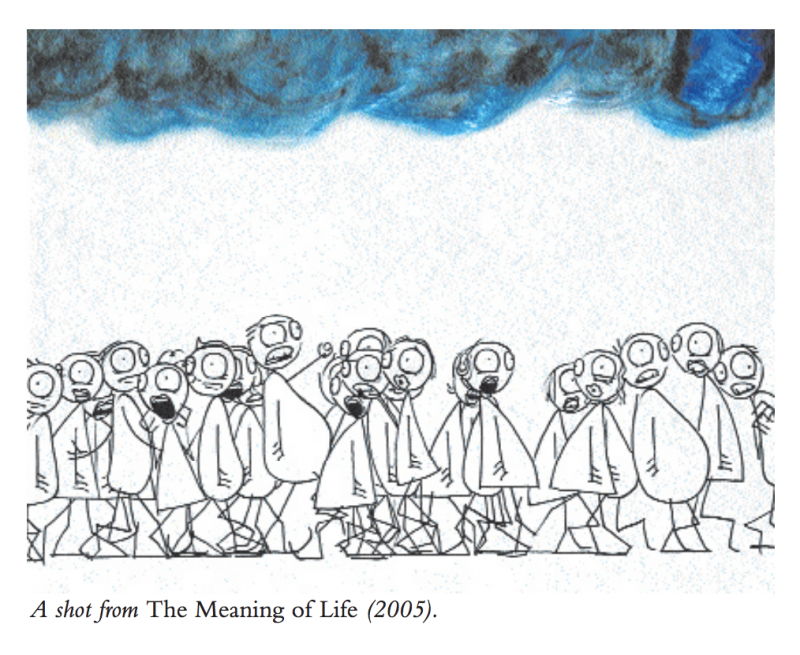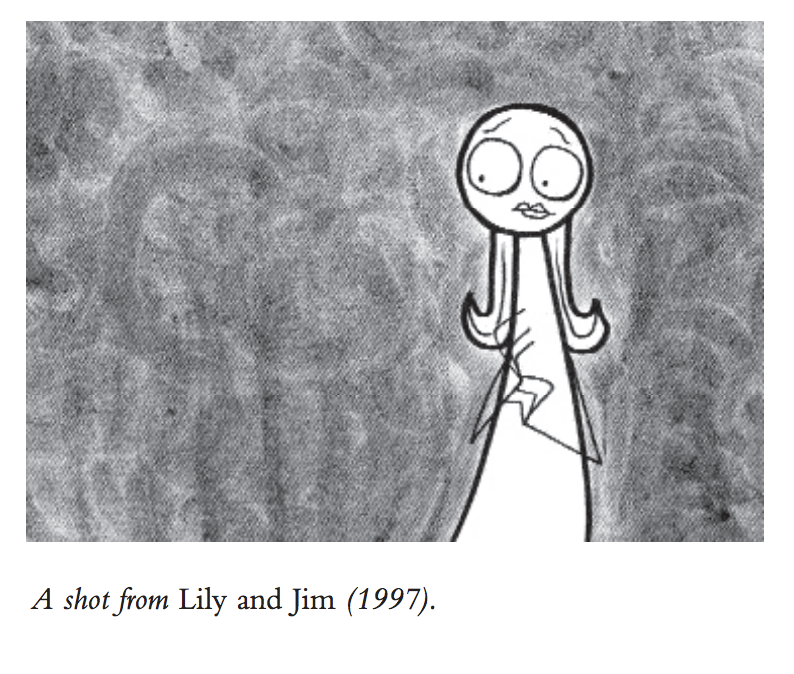Don Hertzfeldt tells stories with stick figures. He brings circles, lines, and dots to life with comedic timing and sadistic, existential emotions: balloons viciously attack children; a blob guy develops an unfortunate bleeding anus. But within the cartoon violence Hertzfeldt cultivates humanistic moments. Lily and Jim puts the melancholy of a blind date under a microscope. The Meaning of Life examines millions of years of evolution and ends with aliens trying to explain it all in their own language. The Academy Award–nominated Rejected lays bare Hertzfeldt’s anxiety about selling his soul to the commercial world—something he has never done.
Although he has help in some arenas, Hertzfeldt’s films truly reflect his own mind and hand. He writes, draws, and shoots everything with his 35 mm camera. No studio, no producers, no computers—he is an auteur of independent animation. Other than animating, he has never held a job, not even as a busboy.
In 2007, Hertzfeldt and Mike Judge launched their third traveling collection of animated shorts, aptly titled the Animation Show. An annual feature-length compilation—the only one run by animators—the festival provides a rare opportunity for new and old animated shorts to play in movie theaters around the world.
I interviewed Don in the Hungry Moose Lodge during the 2007 Sundance Film Festival, where his new film, Everything Will Be OK, won the Best Short Film award. Some follow-up questions took place over his home phone. Don doesn’t have a cell phone, but he just upgraded from dial-up to DSL.
—Mike Plante
 I. “I DON’T GET EXCITED BY FINDING A NEW WAY TO ANIMATE A FALLING LEAF.”
I. “I DON’T GET EXCITED BY FINDING A NEW WAY TO ANIMATE A FALLING LEAF.”
THE BELIEVER: I imagine your parents as hermits who make cabinets, but your dad was a pilot.
DON HERTZFELDT: Yeah, my dad’s a retired pilot and my mom’s a retired librarian. And they’re still together—totally normal.
BLVR: So you started drawing on your own?
DH: My brother and I drew like crazy. It’s hard to remember when or how it started. It was just always there. I had hundreds of drawing pads. We just filled them all in with comic books and really gory war stories. And I wouldn’t let my family or friends just read them; I insisted on showing it all to them. I’d turn the pages and I’d do all the voices and all the sound effects. I’d direct—point to this explosion and then this guy. I guess a primitive attempt to make it like a movie?
BLVR: Were you a fan of cartoons?
DH: I didn’t really read a lot of comic books when I was little, but I’d write my own. I tried to build a video game once, out of a cardboard box and paper. It was based on that old Star Wars polygon game, with asterisks and stuff. I thought I could animate it, like Dragon’s Lair. I’d sit in the box and flip up the paper and try to watch where my brother would move the imaginary controls. It didn’t work.
BLVR: It’s interesting to not have a direct reference.
DH: I always wanted to make movies. I remember seeing The Empire Strikes Back when I was four. I always wanted to be the guy who animated the walkers. But I always thought, going to film school, that I would end up in live action.
BLVR: Film school consisted of traditional classes?
DH: Yeah. I’ve never taken an animation course. When I got there I discovered their 16 mm animation stand, and no one was using the thing. Once a year they would dust it off for an exercise. I asked, “Um, could I use that? And get credit?” “Yeah, if you want.” I just got real lucky; I made my first four movies there in four years and they all found distribution. And I didn’t have to go to a class for it—it was all independent study. I had freedom to use this camera anytime I wanted. That’s kind of a dream come true. At a lot of film schools you’re lucky to touch a camera by your third year. I think the focus for me was sound and editing and story. I never went to art school. I don’t get excited by finding a new way to animate a falling leaf, you know? I’m more: get to the story, get to the point, let the animation serve everything else.
BLVR: What was your favorite class that was nonfilm?
DH: I enjoyed fencing. Half a unit. I was really good at fencing. Not the lame pokey fencing, but saber fencing. You can’t poke. Basically, you whap people. Thicker sword, invented for fighting on horseback. You slash, you whack. That was fun because everyone had bruises after I fought them. The teacher had to come in and kick my ass to teach me a lesson. He would say, “You’re not going to learn anything if you win all the time.” I also took acting. I didn’t want to act after those classes. So discouraging. I liked art history too.
BLVR: Lip-synching to animation looks hard.
DH: I studied Aardman [Animations, whose work in cludes Wallace & Gromit] for that; I figured they did it the best. Once you learn how to break it all down, it’s easy but very tedious. Lily and Jim was all lip-synch. It was important to get that as clean as I could since it was all dialogue-based and everything hin ged on mannerisms. But I was so burned out on lip-synch that the next one, Billy’s Balloon, was basically a si lent movie.
BLVR: And you have to become a director of actors for the voices.
DH: Yeah, and I tend to torture my actors. That’s why I did the narration in Everything Will Be OK. Just a marriage of convenience—I could torture takes out of myself at two in the morning as I kept rewriting.
BLVR: Your voice fits great in the new one.
DH: It’s the one thing I can’t judge. I can look at animation I’ve done and say, that sucks, or, this sound effect or this cut doesn’t work, but everybody hates the sound of their own voice. It was the hardest thing to get used to, take after take. But having your narrator around at all hours for retakes let me rewrite the movie as I went, which I always like to do. Early on I was going to get a movie star, but you only get a couple hours with the person. I like to work with actors and go through a lot more than that.

BLVR: Everything Will Be OK seems much more personal than the sponge guys in Rejected. It’s a story about a person.
DH: Someone at Sundance was talking about how basic Bill [the main character] is: he’s a circle with a couple of dots. But I think sometimes the simpler something is, the more you can empathize with it, the more easily you can project yourself into it. You need to leave that bit of space on the screen for people to dream and get in volved. When you have a movie that has no am biguity—everything’s plotted out and dictating how you’re supposed to think and feel in every scene— the audience has got nothing left to do but watch you writhe around up there. They get elbowed out of the frame.
II. KEEP THE ZOMBIE BRAIN ALIVE.
BLVR: How do your films work across language barriers?
DH: Billy’s Balloon always played well because it’s basically silent—that’s the one that played Cannes— whereas Rejected doesn’t even make sense in English. I can’t imagine what subtitles would do for it. I’ve always wanted to find a copy dubbed in Japanese and then subtitled back to English. It would probably improve it.
BLVR: How many times have you been asked what the meaning of life is?
DH: It’s difficult when people go into an animated short expecting to be told the meaning of life. I don’t know what that tells us about the world. That film [The Meaning of Life] played children’s film festivals— none of my stuff had ever really done that before. And when I talk to kids about it, they really get it. They understand the movie the first time they see it. A lot of folks try to decode movies. They’re trying to figure out a puzzle that might not be there. Kids see it, and—OK, here we are, earth, and it goes around the universe and it comes back to earth, and then here’s this… They accept what they see and don’t try to outthink the movie.
BLVR: Meaning feels less scripted than Rejected or OK. Did the film develop as you were making it?
DH: They’re all pretty intuitive. I’m always rewriting as I go along, and that one took a long time to make. That one was more “scripted” in a sense of Post-it notes and sketches and storyboards scattered around my floor. Every thing Will Be OK and its second chapter, which I’m working on now, are more scripted in a traditional sense, but they always change from day to day too. As soon as I’m done with animation and photography on chapter 2, I have no doubt I’ll be moving scenes around some more and rewriting the narration as I’m recording it. I’ve already changed the ending for chapter 2 twice. Working alone is really the only way you can work like that. Usually in animation you’ve got some story department talking to an art department talking to the animators—you can’t change a single thing down the line or the whole project falls apart. I’ve got a real luxury in being able to change and shape things when I see they need it, or add better ideas when I have them. I can shoot something over a weekend and not answer to anybody. I usually begin without a finished story. For Meaning of Life I just had the opening scene, which took a couple years to animate. So meanwhile the rest of it’s just cooking. I didn’t find the ending on the beach until year three. I guess it’s a high-wire act. You have to have faith a better idea is going to come along. I learned that working on Rejected—you’re animating a comedy and you’re suddenly tired of your jokes after two weeks, yet you still have another few months to get through animating them all. And as soon as you’re not having fun anymore, the whole movie suffers. So I like to keep some element of spontaneity in there and keep improvising.
BLVR: Was Meaning the first film you went insane on?
DH: Pretty close. Those were some depressing years.
BLVR: The story goes: You were so worried about losing your drawings for the film before they were filmed that you bought a fireproof safe for them. Later you decided that safe wasn’t safe enough so you bought a bigger safe and put the first safe inside that. How far in did you buy the first safe?

BLVR: Not that far in. I was a little paranoid. It took about nine months to just animate all those people walking, individually. By the time I was ready to start tracing and compositing them all together, I realized that those final sheets of paper were just terribly precious. I had an entire year of work invested in a single stack of paper. So at the time it did seem logical to get a bigger fireproof safe to put the smaller fireproof safe into. I didn’t want to leave the apartment. When I’d go out and I’d hear sirens I knew it had to be my place going up in flames. So I had to gravitate away from all that and make Everything Will Be OK fast and breezy— didn’t ink anything, didn’t try to pound it all out of the art desk. I got a lot more mileage out of the camera and sound track on that one, and chapter 2 is being made under the same rules.
BLVR: Do you still have the safes?
DH: I still have the safes. Got some negatives in there now.
BLVR: Paper versus animation cel. You just draw on paper?
DH: Yeah. I like the way it looks and it’s easiest to work with. Even if you work with cels you’re going to start on paper and then trace onto the cel. I don’t use cels, because I don’t really bother much with backgrounds.
BLVR: You have the camera that was used to animate some of the Peanuts cartoons.
DH: Yeah, from what I’ve gathered it was probably built in the late 1940s. They say it was considered old in the ’60s. It’s a relic. It’s just microswitches and circuits—very basic, metal. But the camera has a great piece of glass, and inside the casing it’s just two sprockets and the plate. You can’t really improve much on that. I used to shoot with a 16 mm one on campus, just a shorter version of the same idea. I bought this camera in 1999 and have only had three major problems with it since. Usually a switch just needs to be replaced. I can’t say I’ve only had three problems with computers since 1999.
BLVR: How does it feel to think about Rejected now? It’s been a solid cult film for five years.
DH: It’s kind of like it’s not [my] movie anymore. People have tattoos, they wear costumes—it’s a pop-culture thing now. It’s like an abstraction of the original. And I guess you want that of all your movies—to go out and change and turn into their own animal. It’s been weird to watch.
BLVR: Are the tattoos usually the banana?
DH: There’s one guy with the spoon dude all the way down one forearm and the banana down the other arm. At first you want to say, “Are you sure?” ’Cause I spent like thirty seconds designing those characters. It’s cool, but I think forty years from now there will be a lot of removal scars in the shape of my characters on people.
BLVR: You get offered commercial jobs all the time, but you’ve never done one.
DH: I don’t like to think about all the money, but yeah, I’ve never done one. I definitely have my political reasons for that, but I’m also just not good at coming up with stuff from the other end. My best ideas often suddenly appear in the shower or something and I’ll go animate it and it’s all very intuitive and unconscious—I’m not sure where it’s all coming from. But the commercial world relies on a desired result and then working backward to try and find a good idea for it. I’ll have a meeting with a TV guy and he’ll say, “Hey, we’re doing animated Christmas specials. You can do anything you want to—half hour.” And that’s pretty cool, but I can’t think of a goddamn thing. I’m not good at reverse-engineering ideas like that. It’s the same thing with ads. I still look at all this as personal expression. I’ve got nothing to express about paper towels or tampons or Christmas specials. Maybe I’ll wake up one day with a great, deeply personal idea for a toilet paper commercial, but I doubt it.
BLVR: Do you have names for the little guys?
DH: No, I’m really bad with names. “The Animation Show.” Can you come up with a shittier name? Someone asked if Bill [the main character of Everything Will Be OK] was supposed to be Billy from Billy’s Balloon all grown up. I hadn’t even thought of that. I just prefer to use meaningless names that connote an identity and not much else—like Bill or Jim or Lily—or use no name at all. As soon as something’s given a name, it suddenly makes it more relatable, which can be good or bad. Making people have to refer to “those fluffy things” is always gonna make them seem more mysterious and weird than anything I could ever name them.
BLVR: Did you and Mike Judge create the Animation Show tour in order to distribute your films while maintaining control?
DH: It’s nice to have your own tour to send your movies through, but I’m not the only one who needs it. It’s become crucial—no one else is doing this anymore. It’s weird to think that if it weren’t for the [Animation] Show, there would be no short animation distributed to American theaters anymore. All the old festivals have fizzled out and left this giant void for the world’s indie animators. Mike and I were complaining to each other about it in 2001 and decided to do it ourselves. We’re not businessmen. Neither of us is getting paid. Every year we’ve just managed to find new ways to get the next season out there and keep the zombie brain alive.
BLVR: It took a long time to get your Bitter Films: Volume One DVD out.
DH: The restoration work alone was a full-time job. We took all the old 16 mm original camera negatives of everything, digitally cleaned up every frame, painted out all the scratches and damage. It was an incredible expense, but it looks beautiful. Then we went and fleshed out the DVD with all the other bells and whistles that people expect these days. I was animating Everything Will Be OK at the same time as we were working on the DVD, and it was really good for me to kind of close the door on all the old films while working on the new one. I’d be animating one day and then turn around the next to do a DVD menu. You need a lot of different chores to keep your head fresh, I think. You can get really stale just animating 24-7.
BLVR: Do you have any rituals when you finish a film?
DH: Sadly, I don’t. Every time I’m in production on something, especially with Meaning of Life, I’d say, “I’m going to go on a cruise. I’m going to drive to the Grand Canyon. I’m going to do nothing.” But it hasn’t happened yet. The problem is I’ve never had writer’s block. Animating is so slow and boring that all these other ideas for other movies just start piling up in your head. And you start to get really excited about them before you can finish the thing you’re trying to get out the door. So I’ll often finish a film and can only last a week or so before I get stir crazy and all those new ideas drive me straight back to the desk and the cycle continues.
BLVR: So effectively you have been animating since you were—
DH: Eighteen. I’ve never had a long break. I travel a bit with the Animation Show and to film festivals, but technically, that’s still work. But I can’t complain at all. I’m so lucky to be able to do this without needing a day job. There’s a great audience out there now waiting for these films. Every day I’m not working on something I feel a bit stupid, like I’m wasting time.





